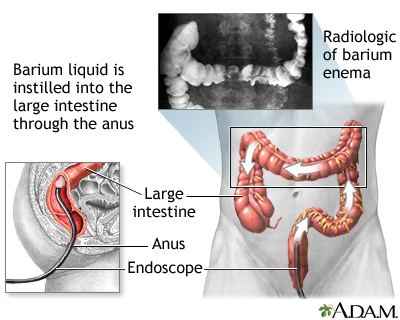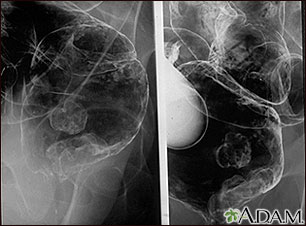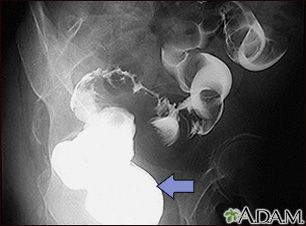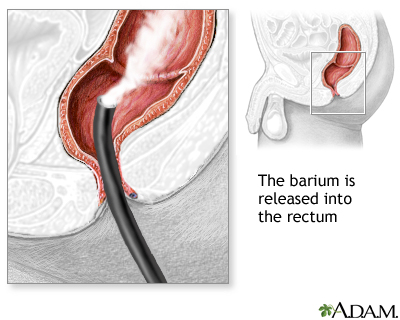Health Library
Barium enema
Lower gastrointestinal series; Lower GI series; Colorectal cancer - lower GI series; Colorectal cancer - barium enema; Crohn disease - lower GI series; Crohn disease - barium enema; Intestinal blockage - lower GI series; Intestinal blockage - barium enema
Barium enema is a special x-ray of the large intestine, which includes the colon and rectum.
Images




I Would Like to Learn About:
How the Test is Performed
This test may be done in a doctor's office or hospital radiology department. It is done after your colon is completely empty and clean. Your doctor will give you instructions for cleansing your colon.
During the test:
- You lie flat on your back on the x-ray table. An x-ray is taken.
- You then lie on your side. The health care provider gently inserts a well-lubricated tube (enema tube) into your rectum. The tube is connected to a bag that holds a liquid containing barium sulfate. This is a contrast material that highlights specific areas in the colon, creating a clear image.
- The barium flows into your colon. X-rays are taken. A small balloon at the tip of the enema tube may be inflated to help keep the barium inside your colon. The provider monitors the flow of the barium on an x-ray screen.
- Sometimes a small amount of air is delivered into the colon to expand it. This allows for even clearer images. This test is called a double contrast barium enema.
- You are asked to move into different positions. The table is slightly tipped to get different views. At certain times when the x-ray pictures are taken, you are told to hold your breath and be still for a few seconds so the images will not be blurry.
- The enema tube is removed after the x-rays are taken.
- You are then given a bedpan or helped to the toilet, so you can empty your bowels and remove as much of the barium as possible. Afterward, 1 or 2 more x-rays may be taken.
How to Prepare for the Test
Your bowels need to be completely empty for the exam. If they are not empty, the test may miss a problem in your large intestine.
You will be given instructions for cleansing your bowel using an enema or laxatives. This is also called bowel preparation. Follow the instructions exactly.
For 1 to 3 days before the test, you need to be on a clear liquid diet. Examples of clear liquids are:
- Clear coffee or tea
- Fat-free bouillon or broth
- Gelatin
- Sports drinks
- Strained fruit juices
- Water
How the Test will Feel
When barium enters your colon, you may feel like you need to have a bowel movement. You may also have:
- A feeling of fullness
- Moderate to severe cramping
- General discomfort
Taking long, deep breaths may help you relax during the procedure.
It is normal for the stools to be white for a few days after this test. Drink extra fluids for 2 to 4 days. Ask your doctor about a laxative if you develop hard stools.
Why the Test is Performed
Barium enema is used to:
- Detect or screen for colon cancer
- Diagnose or monitor ulcerative colitis or Crohn disease
- Diagnose the cause of blood in stools, diarrhea, or very hard stools (constipation)
The barium enema test is used much less often than in the past. Colonoscopy is done more often now.
Normal Results
Barium should fill the colon evenly, showing normal bowel shape and position and no blockages.
What Abnormal Results Mean
Abnormal test results may be a sign of:
- Blockage of the large intestine
- Narrowing of the colon above the rectum (Hirschsprung disease in infants)
- Crohn disease or ulcerative colitis
- Cancer in the colon or rectum
- Sliding of one part of the intestine into another (intussusception)
- Small growths that stick out of the lining of the colon, called polyps
- Small, bulging sacs or pouches of the inner lining of the intestine, called diverticula
- Twisted loop of the bowel (volvulus)
Risks
There is low radiation exposure. X-rays are monitored so that the smallest amount of radiation is used. Pregnant women and children are more sensitive to x-ray risks.
A rare, but serious, risk is a hole made in the colon (perforated colon) when the enema tube is inserted.
Related Information
X-rayColorectal cancer
Cancer
Diverticulitis
Tumor
Mucosa
Ulcerative colitis
Irritable bowel syndrome
Appendicitis
Annular pancreas
CMV - gastroenteritis/colitis
Colorectal polyps
Crohn disease
Hirschsprung disease
Intestinal obstruction and Ileus
Intussusception – children
Pyloric stenosis in infants
References
Boland GWL. Colon and appendix. In: Boland GWL, ed. Gastrointestinal Imaging: The Requisites. 4th ed. Philadelphia, PA: Elsevier Saunders; 2014:chap 5.
Boone D, Plumb A, Taylor SA. The large bowel. In: Adam A, Dixon AK, Gillard JH, Schaefer-Prokop CM, eds. Grainger & Allison's Diagnostic Radiology. 7th ed. Philadelphia, PA: Elsevier; 2021:chap 22.
US Preventive Services Task Force website. Final recommendation statement. Colorectal cancer: screening. www.uspreventiveservicestaskforce.org/uspstf/recommendation/colorectal-cancer-screening. Published May 18, 2021. Accessed May 27, 2022.
BACK TO TOPReview Date: 2/7/2022
Reviewed By: Michael M. Phillips, MD, Emeritus Professor of Medicine, The George Washington University School of Medicine, Washington, DC. Also reviewed by David Zieve, MD, MHA, Medical Director, Brenda Conaway, Editorial Director, and the A.D.A.M. Editorial team.
 | A.D.A.M., Inc. is accredited by URAC, for Health Content Provider (www.urac.org). URAC's accreditation program is an independent audit to verify that A.D.A.M. follows rigorous standards of quality and accountability. A.D.A.M. is among the first to achieve this important distinction for online health information and services. Learn more about A.D.A.M.'s editorial policy, editorial process and privacy policy. A.D.A.M. is also a founding member of Hi-Ethics. This site complies with the HONcode standard for trustworthy health information: verify here. |
The information provided herein should not be used during any medical emergency or for the diagnosis or treatment of any medical condition. A licensed medical professional should be consulted for diagnosis and treatment of any and all medical conditions. Links to other sites are provided for information only -- they do not constitute endorsements of those other sites. © 1997- 2022 A.D.A.M., a business unit of Ebix, Inc. Any duplication or distribution of the information contained herein is strictly prohibited.
